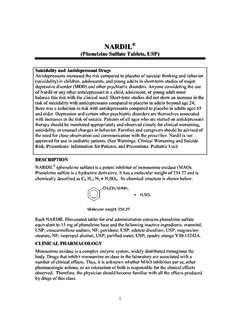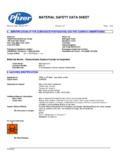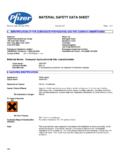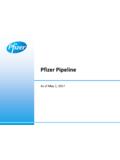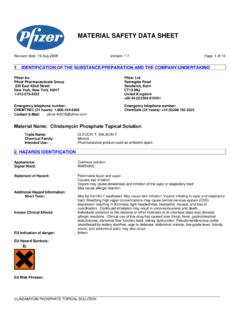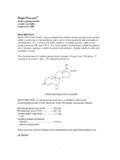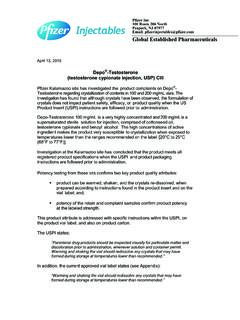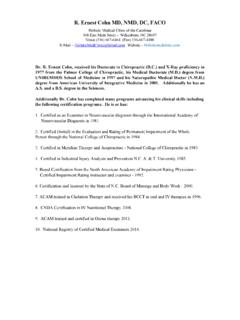Transcription of Bicillin C-R PRECAUTIONS, DOSAGE AND …
1 Bicillin C-R(penicillin G benzathine and penicillin G procaine injectable suspension)Disposable Syringefor deep IM injection onlyWARNING: NOT FOR INTRAVENOUS USE. DO NOT INJECT INTRAVENOUSLY OR ADMIX WITH OTHER INTRAVENOUS SOLUTIONS. THERE HAVE BEEN REPORTS OF INADVERTENT INTRAVENOUS ADMINISTRATION OF PENICILLIN G BENZATHINE WHICH HAS BEEN ASSOCIATED WITH CARDIORESPIRATORY ARREST AND DEATH. Prior to administration of this drug, care-fully read the WARNINGS, ADVERSE REACTIONS, and DOSAGE AND ADMINISTRATION sections of the OnlyDESCRIPTIONB icillin C-R (penicillin G benzathine and penicillin G procaine injectable suspension) contains equal amounts of the benzathine and procaine salts of penicillin G. It is available for deep intramuscular G benzathine is prepared by the reaction of dibenzyleth-ylene diamine with two molecules of penicillin G.
2 It is chemically designated as (2S,5R,6R)-3,3-Dimethyl-7-oxo-6-(2-pheny lacetamido)-4-thia-1-azabicyclo[ ]heptane-2-carboxylic acid compound with N,N -dibenzylethylenediamine (2:1), tetrahydrate. It occurs as a white, crystalline powder and is very slightly soluble in water and sparingly soluble in alcohol. Its chemical structure is as follows: Molecular Formula Molecular Wt.(C16H18N2O4S)2 C16H20N2 4H2O G procaine, (2S,5R,6R)-3,3-Dimethyl-7-oxo-6-(2-pheny lacetamido)-4-thia-1-azabicyclo[ ]heptane-2-carboxylic acid compound with 2-(diethylamino)ethyl p-aminobenzoate (1:1) mono-hydrate, is an equimolar salt of procaine and penicillin G. It occurs as white crystals or a white, microcrystalline powder and is slightly soluble in water. Its chemical structure is as follows: Molecular Formula Molecular Wt. C16H18N2O4S C13H20N2O2 H2O disposable syringe (2 mL size) contains the equivalent of 1,200,000 units of penicillin G comprising: the equivalent of 600,000 units of penicillin G as the benzathine salt and the equivalent of 600,000 units of penicillin G as the procaine salt in a stabilized aqueous suspension with sodium citrate buffer; and as w/v, approximately lecithin, carboxymethylcellulose, povidone, methylparaben, and C-R injectable suspension in the disposable-syringe formula-tion is viscous and opaque.
3 Read CONTRAINDICATIONS, WARNINGS, precautions , and DOSAGE AND ADMINISTRATION sections prior to PHARMACOLOGYG eneralPenicillin G benzathine and penicillin G procaine have a low solubility and, thus, the drugs are slowly released from intramuscular injection sites. The drugs are hydrolyzed to penicillin G. This combination of hydrolysis and slow absorption results in blood serum levels much lower but more prolonged than other parenteral administration of 600,000 units of Bicillin C-R in adults usually produces peak blood levels of to units per mL within 3 hours; this level falls to an average concentration of units per mL at 12 hours, units per mL at 24 hours, and units per mL at seven administration of 1,200,000 units of Bicillin C-R in adults usually produces peak blood levels of to units per mL within 3 hours; this level falls to an average concentration of units per mL at 12 hours, units per mL at 24 hours, and units per mL at seven 60% of penicillin G is bound to serum protein.
4 The drug is distributed throughout the body tissues in widely varying amounts. Highest levels are found in the kidneys with lesser amounts in the liver, skin, and intestines. Penicillin G penetrates into all other tissues and the spinal fluid to a lesser degree. With normal kidney function, the drug is excreted rapidly by tubular excretion. In neonates and young infants and in individuals with impaired kidney function, excretion is consider-ably G exerts a bactericidal action against penicillin-susceptible microorganisms during the stage of active multiplication. It acts through the inhibition of biosynthesis of cell-wall mucopeptide. It is not active against the penicillinase-producing bacteria, which include many strains of staphylococci. The following in vitro data are available, but their clinical significance is unknown.
5 Penicillin G exerts high in vitro activity against staphylococci (except penicillinase-producing strains), streptococci (Groups A, C, G, H, L, and M), and pneumococci. Other organisms susceptible to penicil-lin G are Neisseria gonorrhoeae, Corynebacterium diphtheriae, Bacillus anthracis, Clostridia species, Actinomyces bovis, Streptobacillus monili-formis, Listeria monocytogenes, and Leptospira species. Treponema pallidum is extremely susceptible to the bactericidal action of penicillin Test: If the Kirby-Bauer method of disc susceptibility is used, a 10-unit penicillin disc should give a zone greater than 28 mm when tested against a penicillin-susceptible bacterial AND USAGEThis drug is indicated in the treatment of moderately severe infections due to penicillin-G-susceptible microorganisms that are susceptible to serum levels common to this particular DOSAGE form.
6 Therapy should be guided by bacteriological studies (including susceptibility testing) and by clinical C-R is indicated in the treatment of the following in adults and pediatric patients:Moderately severe to severe infections of the upper-respiratory tract, scarlet fever, erysipelas, and skin and soft-tissue infections due to susceptible : Streptococci in Groups A, C, G, H, L, and M are very sensitive to penicillin G. Other groups, including Group D (enterococci), are resistant. Penicillin G sodium or potassium is recommended for streptococcal infec-tions with severe pneumonia and otitis media due to susceptible : Severe pneumonia, empyema, bacteremia, pericarditis, meningi-tis, peritonitis, and arthritis of pneumococcal etiology are better treated with penicillin G sodium or potassium during the acute high, sustained serum levels are required, penicillin G sodium or potassium, either IM or IV, should be used.
7 This drug should not be used in the treatment of venereal diseases, including syphilis, gonorrhea, yaws, bejel, and previous hypersensitivity reaction to any penicillin or to procaine is a : NOT FOR INTRAVENOUS USE. DO NOT INJECT INTRAVENOUSLY OR ADMIX WITH OTHER INTRAVENOUS SOLUTIONS. THERE HAVE BEEN REPORTS OF INADVERTENT INTRAVENOUS ADMINISTRATION OF PENICILLIN G BENZATHINE WHICH HAS BEEN ASSOCIATED WITH CARDIORESPIRATORY ARREST AND DEATH. Prior to administration of this drug, care-fully read the WARNINGS, ADVERSE REACTIONS, and DOSAGE AND ADMINISTRATION sections of the combination of penicillin G benzathine and penicillin G procaine should only be prescribed for the indications listed in this AND OCCASIONALLY FATAL HYPERSENSITIVITY (ANAPHYLACTIC) REACTIONS HAVE BEEN REPORTED IN PATIENTS ON PENICILLIN THERAPY.
8 THESE REACTIONS ARE MORE LIKELY TO OCCUR IN INDIVIDUALS WITH A HISTORY OF PENICILLIN HYPERSENSITIVITY AND/OR A HISTORY OF SENSITIVITY TO MULTIPLE ALLERGENS. THERE HAVE BEEN REPORTS OF INDIVIDUALS WITH A HISTORY OF PENICILLIN HYPERSENSITIVITY WHO HAVE EXPERIENCED SEVERE REACTIONS WHEN TREATED WITH CEPHALOSPORINS. BEFORE INITIATING THERAPY WITH Bicillin C-R CAREFUL INQUIRY SHOULD BE MADE CONCERNING PREVIOUS HYPERSENSITIVITY REACTIONS TO PENICILLINS, CEPHALOSPORINS OR OTHER ALLERGENS. IF AN ALLERGIC REACTION OCCURS, Bicillin C-R SHOULD BE DISCONTINUED AND APPROPRIATE THERAPY INSTITUTED. SERIOUS ANAPHYLACTIC REACTIONS REQUIRE IMMEDIATE EMERGENCY TREATMENT WITH EPINEPHRINE. OXYGEN, INTRAVENOUS STEROIDS AND AIRWAY MANAGEMENT, INCLUDING INTUBATION, SHOULD ALSO BE ADMINISTERED AS INDICATED. Clostridium difficile associated with diarrhea (CDAD) has been reported with use of nearly all antibacterial agents, including Bicillin C-R, and may range in severity from mild diarrhea to fatal colitis.
9 Treatment with antibacterial agents alters the normal flora of the colon leading to overgrowth of C. difficile produces toxins A and B which contribute to the development of CDAD. Hyptertoxin producing strains of C. difficile cause increased morbidity and mortality, as these infections can be refractory to antimi-crobial therapy and may require colectomy. CDAD must be considered in all patients who present with diarrhea following antibiotic use. Careful medical history is necessary since CDAD has been reported to occur over two months after the administration of antibacterial CDAD is suspected or confirmed, ongoing antibiotic use not directed against C. difficile may need to be discontinued. Appropriate fluid and electrolyte management, protein supplementation, antibiotic treat-ment of C. difficile, and surgical evaluation should be instituted as clinically of AdministrationDo not inject into or near an artery or into or near a nerve may result in permanent neurological intravascular administration, including inadvertent direct intra-arterial injection or injection immediately adjacent to arteries, of Bicillin C-R and other penicillin preparations has resulted in severe neurovascular damage, including transverse myelitis with permanent paralysis, gangrene requiring amputation of digits and more proximal portions of extremities, and necrosis and sloughing at and surrounding the injection site.
10 Such severe effects have been reported following injections into the buttock, thigh, and deltoid areas. Other serious com-plications of suspected intravascular administration which have been reported include immediate pallor, mottling, or cyanosis of the extremity both distal and proximal to the injection site, followed by bleb formation; severe edema requiring anterior and/or posterior compartment fasci-otomy in the lower extremity. The above-described severe effects and complications have most often occurred in infants and small children. Prompt consultation with an appropriate specialist is indicated if any evidence of compromise of the blood supply occurs at, proximal to, or distal to the site of (See precautions , and DOSAGE AND ADMINISTRATION sections.)Do not inject intravenously or admix with other intravenous solutions.
